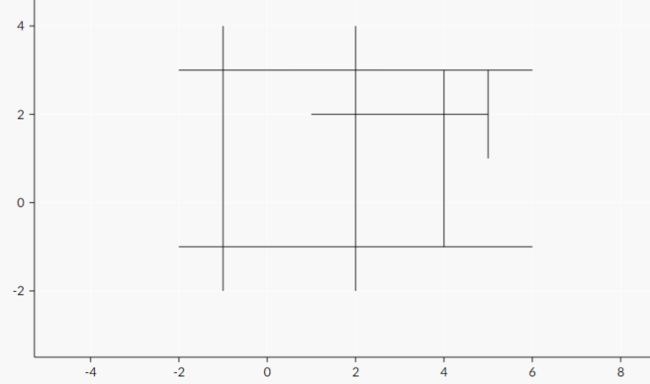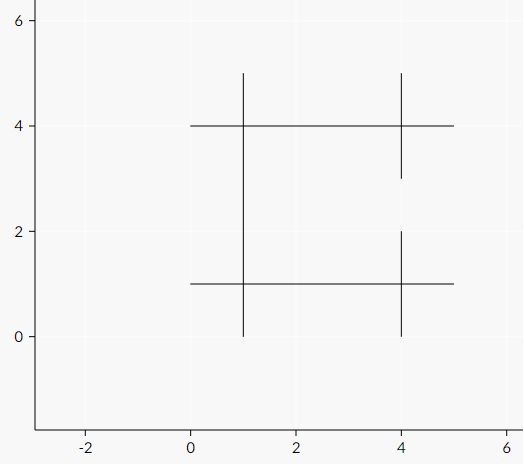「CF1194E」Count The Rectangles【树状数组】
E. Count The Rectangles
There are n n n segments drawn on a plane; the i − t h i-th i−th segment connects two points ( x i 1 , y i , 1 ) (x_{i1}, y_{i,1}) (xi1,yi,1) and ( x i , 2 , y i , 2 ) (x_{i,2}, y_{i,2}) (xi,2,yi,2). Each segment is non-degenerate, and is either horizontal or vertical — formally, for every ?∈[1,?] either x i , 1 = x i , 2 x_{i,1}=x_{i,2} xi,1=xi,2 or y i , 1 = y i , 2 y_{i,1}=y_{i,2} yi,1=yi,2 (but only one of these conditions holds). Only segments of different types may intersect: no pair of horizontal segments shares any common points, and no pair of vertical segments shares any common points.
We say that four segments having indices h 1 , h 2 , v 1 a n d v 2 h_1, h_2, v_1 and v_2 h1,h2,v1andv2 such that h 1 < h 2 h_1<h_2 h1<h2 and v 1 < v 2 v_1<v_2 v1<v2 form a rectangle if the following conditions hold:
segments h 1 h_1 h1 and h 2 h_2 h2 are horizontal;
segments v 1 v_1 v1 and v 2 v_2 v2 are vertical;
segment h 1 h_1 h1 intersects with segment v 1 v_1 v1;
segment h 2 h_2 h2 intersects with segment v 1 v_1 v1;
segment h 1 h_1 h1 intersects with segment v 2 v_2 v2;
segment h 2 h_2 h2 intersects with segment v 2 v_2 v2.
Please calculate the number of ways to choose four segments so they form a rectangle. Note that the conditions h 1 < h 2 h_1<h_2 h1<h2 and v 1 < v 2 v_1<v_2 v1<v2 should hold.
Input
The first line contains one integer n ( 1 ≤ n ≤ 5000 ) n (1\leq n\leq 5000) n(1≤n≤5000) — the number of segments.
Then n n n lines follow. The i − t h i-th i−th line contains four integers x i , 1 , y i , 1 , x i , 2 x_{i,1}, y_{i,1}, x_{i,2} xi,1,yi,1,xi,2 and y i , 2 y_{i,2} yi,2 denoting the endpoints of the i − t h i-th i−th segment. All coordinates of the endpoints are in the range [ − 5000 , 5000 ] [−5000,5000] [−5000,5000].
It is guaranteed that each segment is non-degenerate and is either horizontal or vertical. Furthermore, if two segments share a common point, one of these segments is horizontal, and another one is vertical.
Output
Print one integer — the number of ways to choose four segments so they form a rectangle.
Examples
input
7
-1 4 -1 -2
6 -1 -2 -1
-2 3 6 3
2 -2 2 4
4 -1 4 3
5 3 5 1
5 2 1 2
output
7
input
5
1 5 1 0
0 1 5 1
5 4 0 4
4 2 4 0
4 3 4 5
output
0
Note
The following pictures represent sample cases:


题意
- 给你 n n n条平行于 x x x轴或者 y y y轴的直线,求能构成多少个不同的矩形
题解
- 暴力用树状数组维护一下就行了
代码
#include